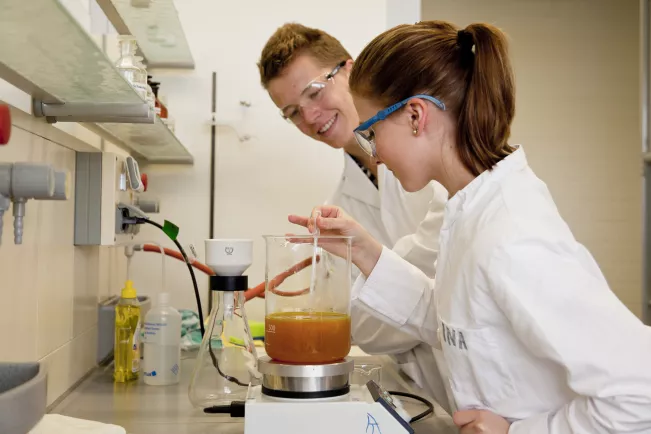Department of Natural Sciences
General Chemistry

Lecture
Lecture (content):
- Atomic structure, Bohr-Rutherford model of the atom, orbital model, atomic spectra
- Structure of the periodic table of the elements
- Chemical bonds: ionic bond, covalent bond, metallic bond, coordinate covalent bond, intermolecular bonds
- Chemical reactions: reaction kinetics, chemical equilibrium, Law of Mass Action, reaction types, reaction energy (thermochemistry)
- Acids and bases, pH, dissociation constant, calculation of pH, titration, buffer systems
- Solubility products
- Redox reactions: redox potential, Galvanic cells
Exercises
Practical Course
Practical Class
- During six lab-days students run practical experiments on acid/base-reactions, titration, pH-value, mass action law, reaction kinetics, electrochemistry, simple synthesis.
- Experiment 1: Preparation of Fluorescein
- Experiment 2: Use of the Law of Mass Action/Chemical Equilibrium
- Experiment 3: Acid-/Basetitration and Buffer Systems
- Experiment 4: Electrochemistry
- Experiment 5: Complex-Formation Reactions
→ Download lecture notes and exercises (LEA)
Requirements
For the participation in lectures or exercises: there are no specific entry requirements;
for the participation in practical class: successful attendance to the Safety Instructions (part of the introduction weeks, always in September/October) is mandatory!
Modalities of examination
successful participation in the practical course, documented by lab reports and/or post-lab quizzes (non-graded)
final modular examination in writing (120 min) - graded
For the whole module 7 ECTS are allocated.
More details will be explained during the first lecture.
Literature
Recommended literature
1. Ebbing, D.D., Gammon S.D., General Chemistry, 7th Ed., Houghton Mifflin Company, Boston, New York, 2002
2. Mortimer, C., Chemie, Thieme Verlag
Links
Further links